How to engage government in Collective Action?
As we soon approach the one year anniversary of the 2014 ICCA Conference "Collective Action: Going Further Together to Counter Corruption" this blog piece returns to one of the key messages to emerge from the event, on the topic of engagement with government in Collective Action.
Corruption happens mostly at the interface between business and public authorities. Consequently, effective anti-corruption measures need to engage both parties. The same is true when it comes to Collective Action, and indeed the need to involve or engage with governments and the public sector as part of the Collective Action approach to bribery emerged as a key theme throughout the conference.
Manners of engagement with government
However, it has become clear that the manner in which to approach government has to be highly contextualized. Factors that may influence the way companies choose to engage include the level of trust of companies in the integrity of the public sector and the degree of political will of the government; the capacity of the concerned public institutions to implement sustainable anti-corruption reforms; and the convening power of the members of the Collective Action, etc.
Illustrative of this are the different approaches chosen in Colombia and Ukraine in relation to the establishment of mechanisms to handle corruption complaints by individual companies. While the High Level Reporting Mechanism in Colombia is attached to the Office of the President of Colombia and thus an integral part of the government and the country’s public administration, the Business Ombudsman Institution has steered towards a more independent structure.
Another difference emerging from different contributions at the conference related to the timing of engagement with government. While in some cases such engagement should occur from the very start, in other cases it has proven to be more sustainable if businesses first work among themselves to establish trust and a strong alliance, before then engaging government.
A question that also needs to be addressed on a case-by-case basis is whether companies should approach one or several specific agencies or try to engage with government as a whole and in a more encompassing manner. Ultimately the decision in this regard is to be taken in light of the particular objective(s) of a given Collective Action and, again, the level of trust that companies have in the concerned agency or government as a whole.
Potential challenges and remedies
Involving government in a Collective Action is faced with a number of potential challenges. These include, notably, the risk of being perceived as yet another industry lobby group, a risk that is especially there if the Collective Action is industry specific. Taking a cross-industry approach to the particular engagement with government may help overcome such suspicion.
Another frustrating experience discussed during the conference may be that while top-level officials are highly supportive of actions proposed by a group of companies, the implementation of said actions is blocked by mid-level officials, either due to lack of interest or their direct involvement in the concerned corruption problem.
In some instances, it is the whole government, which is non-responsive to any attempt to jointly engage in anti-corruption efforts, most likely because of a high level of state capture. In these situations it is clearly advisable that Collective Action initiatives delay the involvement of the public sector with a view to creating realities that cannot be ignored anymore by the concerned state actors. For such an approach to work, however, the alliance of business partners must be extremely strong and participating companies ideally must jointly bring together considerable market strength.
Finally, in the face of high levels of state capture, but also more broadly, experience shows that identifying and creating an alliance with a known integrity champion from within government / the public sector and with a sufficiently high profile can often be a key to unlocking relationships with government, or at least with selected agencies. In the same logic, the use of leverages, for example identifying government policy priorities and how the concerned Collective Action can contribute towards the achievement of these objectives, is another way into a constructive collaboration with government / the public sector when the willingness to do so is not immediately apparent by all stakeholders.



